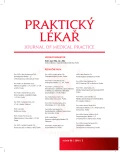Basics of respiratory physiotherapy for general practitioners
Authors:
L. Máchová 1,2; R. Poděbradská 1,3; M. Stepaňuková 3
Authors‘ workplace:
Masarykova univerzita, Brno Katedra podpory zdraví Vedoucí: MUDr. Kapounková Kateřina, Ph. D.
1; Rehaspiro, Praha (fyzioterapeut OSVČ)
2; Rehabilitace Lipová-lázně Primář: MUDr. Poděbradský Jiří
3
Published in:
Prakt. Lék. 2018; 98(3): 104-108
Category:
Of different specialties
Overview
Breathing difficulties of patients coming to a general practitioner’s ambulance may have different aetiologies. However, regardless of aetiology, all respiratory diseases have a similar impact in the area of the locomotor system – a change in the breathing stereotype. If a change in the respiratory stereotype persists, mostly within chronic or repeated acute respiratory diseases, a change in the respiratory stereotype may occur in aetiology in the future. Sending patients to respiratory physiotherapy in these cases is still not a standard part of a treatment. Possible reasons can be caused by relatively high occupancy rate of the rehabilitation or due to another treatment and additional burdening the patient. Nevertheless, from the point of view of physiotherapy, there are several completely basic regimes and recommendations that can be put into therapy and positively influencing the outcome of the treatment.
Keywords:
respiratory physiotherapy – respiratory tract illness
Sources
1. Bernardi L, Wdowczyk-Szulc J, Valenti C, et al. Effects of controlled breathing, mental activity and mental stress with or without verbalization on heart rate variability. J Am Coll Cardiol 2000; 35(6): 1462–1469.
2. Casale M, Sabatino L, Moffa A, et al. Breathing training on lower esophageal sphincter as a complementary treatment of gastroesophageal reflux disease (GERD): a systematic review. Eur Rev Med Pharmacol Sci 2016; 20(21): 4547–4552.
3. Dominelli PB, Sheel AW. Experimental approches to the study of the mechanics of breathing during exercise. Respir Physiol Neurobiol 2012; 180(2–3): 147–161.
4. Levin OS, Polunina AG, Demyanova MA, Isaev FV. Steroid myopathy in patients with chronic respiratory diseases. J Neurol Sci 2014; 338(1–2): 96–101.
5. Lewit K. Manipulační léčba. 5. vydání. Praha: Nakladatelství Sdělovací technika a Česká lékařská společnost J. E. Purkyně 1996.
6. Máček M. Pohybová aktivita při chronických chorobách dýchacího ústrojí u dětí a dospělých. Med Sport Boh Slov 2001; 10 : 1–10.
7. Máček M, Máčková J, Smolíková L, Radvanský J. Porucha funkce svalů dolních končetin v průběhu chronické obstrukční plicní nemoci (CHOPN). Prakt. Lék. 2009; 89(11): 634–638.
8. Neumannová K, Kolek V, a kol. Asthma bronchiale a chronická plicní nemoc. Možnosti komplexní léčby z pohledu fyzioterapeuta. Praha: Mladá fronta 2012.
9. Neumannová K, Zatloukal J. Ovlivnění poruch dýchání pomocí tréninku dýchacích svalů. Rehabil. fyz. Lék. 2011; 18(4): 188–192.
10. Olsén MF, Lannefors L, Westerdahl E. Positive exspiratory pressure – Common clinical applications and physiological effect. Respir Med 2015; 109(3): 297–307.
11. Poděbradský J, Poděbradská R. Fyzikální terapie – manuál a algoritmy. Praha: Grada Publishing 2009.
12. Sandes A, Andersen T, Hilland M, et al. Laryngeal movements during inspiratory muscle training in healthy subjects. J Voice 2013; 27(4): 448–453.
13. Smolíková L. Respirační fyzioterapie není jen o dýchání. Umění fyzioterapie 2017; 4 : 21–27.
14. Smolíková L, Máček M. Respirační fyzioterapie a plicní rehabilitace. Brno: Národní centrum ošetřovatelství a nelékařských zdravotnických oborů 2010.
15. Urbánková P. Chronické záněty horních dýchacích cest. Med pro Praxi 2007; 4(9): 416–418.
Labels
General practitioner for children and adolescents General practitioner for adultsArticle was published in
General Practitioner

2018 Issue 3
Most read in this issue
- Preoperative anaemia: prevalence, causes, consequences, and management
- Overview of questionnaires and scales of the motor symptoms of patients with Parkinson’s disease
- Treatment of immunodeficiency by subcutaneous immunoglobulins
- Basics of respiratory physiotherapy for general practitioners
